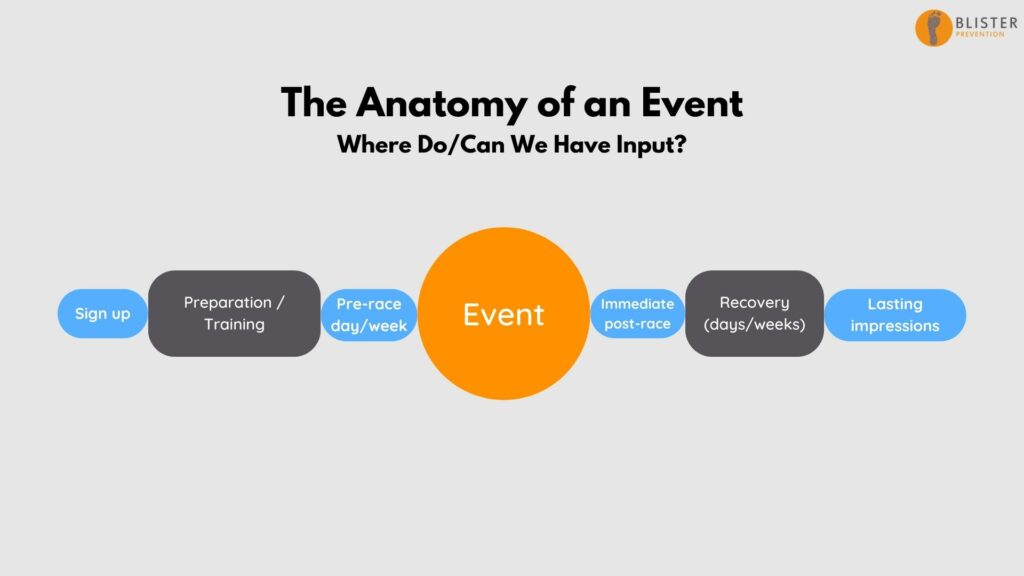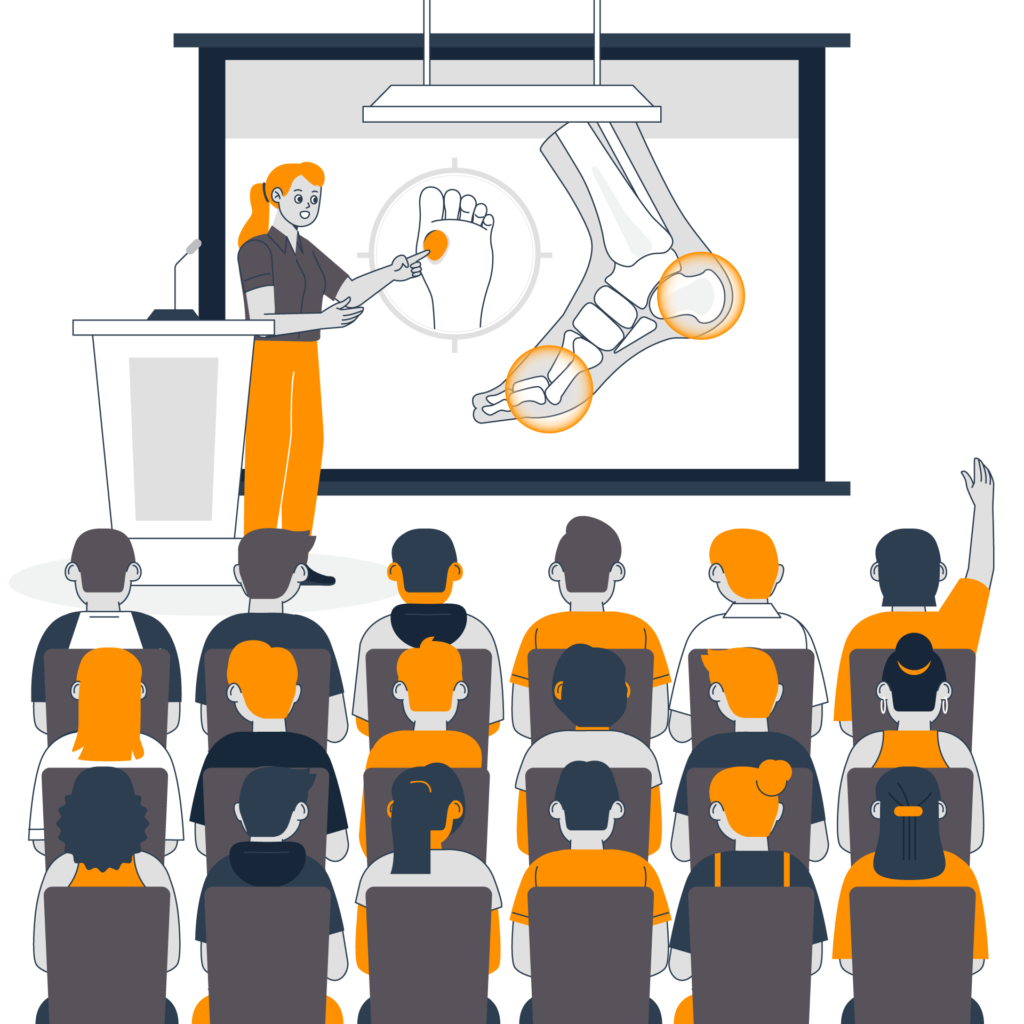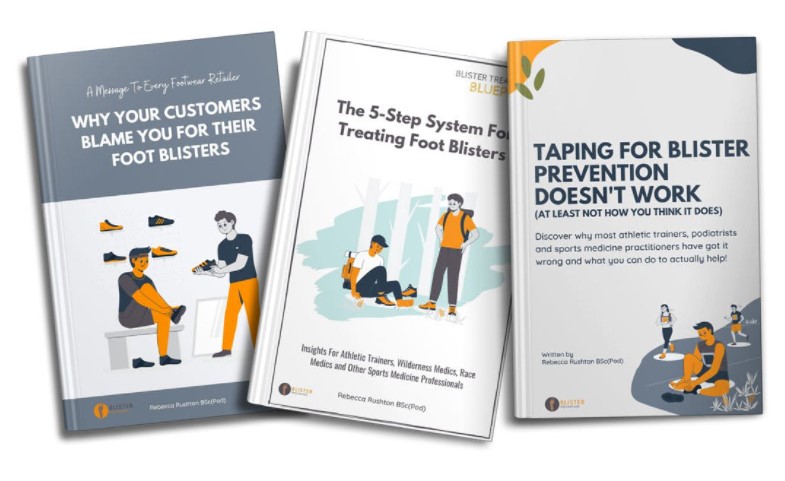Alright, well I might make a start. So, thank you for joining me for this little chat about providing athletic event foot blister management. Providing foot care at events something that I do every year and something I think is important – and fun! So if you’re volunteering your time at an athletic event to provide foot care, basically 95% to 100% of your time and effort will be spent managing blisters.
If we have a look at the different types of races. They vary in terms of:
- Distance/duration: I think it’s fair to say, the longer you run or walk, the more likely you are to get blisters. So if you’re at one of the long events, you’ll be definitely seeing a lot of blisters.
- Blister locations: You’ll see different types of blisters or different blister locations depending on the event. For example, the blisters on the back of the heel are more common in walking events than in running events.
- Participant experience: There’s going to be a wide variety of the participants in every event. For example, in a marathon, you’ll have people that run marathon distances frequently, and others either haven’t trained as diligently as they intended to, or they just signed up for fun, maybe with a friend, maybe just to tick it off their bucket list. This is especially the case at fun runs and events with a fundraising component.
- Foot care service: Some races have foot care and others don’t.
- Pre-race education: Some races provide some level of advice, even if minimal. Certainly a lot of them don’t.
Ideal athletic event foot blister management
So there’s a lot of variability to the races. But if we look any every race, it has certain stages where we can think about what our role is and how we can have the biggest impact. Is it blister treatment? Is it blister prevention? Or is it a bit of both? Or is it just to get some CPD points? Is it even important? I mean, a lot of people think that blisters aren’t that big a deal. They believe they’re a rather insignificant injury at worst.
But you and I know, as do many athletes, that blisters can adversely affect performance. They can adversely affect their gait and adversely affect their experience during the event. Event organisers will be tuned into that. If we really do value our role as foot health experts, I think we would have to say that this is important.
If we’re providing foot care and events, we want to be good at it, right? So, when should we be having input, for maximum effect? Should it be during the race only? Should it be at the finish line, putting Band-Aids on blisters? Or should it be before the event? How should we be having input? If we’re providing pre-event education, should that be in-person, should it be online? Do we want to do PowerPoint presentations to groups, or webinars? Do we simply provide blister treatment, or should we try and educate during the treatment episode? What resources are needed? Who pays for it?
If we use Oxfam TrailWalker as an example, they pay for a lot of gear! They put massive effort into having a podiatry presence at their events. But is the equipment and the consumables they provide adequate? Do they allow us to do everything we need to do with blisters to maximise pain-relief?
Anatomy of an athletic event

Let’s have a look at my ideal blister management scenario.
Sign-up
There’s not really much that you can do at the sign-up stage when the participant is mainly just excited to be part of the event. However, I’d like to think that the web event website may have some information about the prevalence of blisters. And even something where they encourage participants to seek podiatry advice so that they can maximise their experience at this event.
Preparation and training
This is where the most important work is done, in my opinion. To my way of thinking, if podiatry only had input at only one stage of an event, it must be here. This could be in the form of a PowerPoint presentation, an in-person education event, a webinar, providing advice through a private Facebook group – there are lots of ways. But it has to be good – it has to be more than just the “get shoes that fit well and moisture-wicking socks” message. This kind of advice is far too basic and common sense to be of any real benefit. I wouldn’t be happy if I made the effort to turn up or tune in and that’s all I got. What you should do when you’re delivering a presentation is you want to alert people to the fact that there’s new information about blisters, that blisters are predictable, and that will pique their interest. Because, as far as they’re concerned, blisters are completely unpredictable. And they may think they’ve tried everything under the sun, they haven’t. They might have dabbled. But what they need to do is think about blisters, not as a single problem requiring a single solution. Blisters need to be address per anatomical site. And strategies applied according to the specific structural and functional factors behind that blister site.
The aim of the presentation, no matter how you give it, is to get those people that are interested, to come and see you for a consultation so that you can help them identify and predict those blisters that they’re most likely to get. And to show them the best ways for preventing them. That is what constitutes a blister plan. A blister plan is a valuable piece of information. You’re teaching people new things. They have preconceived ideas, you’re shattering those beliefs, so thye need it written down. This will set them up for success as the ytrain and prepare for this event.
If you want to provide the best kind of pre-race education, but don’t have the time or resources to do it, there’s always the Fix My Foot Blisters Fast course. That’s a course that I created in 2016 that has been hugely successful. It gets great feedback. It has literally been designed for people about to embark on something out of the ordinary, even if they’re blister prone. It walks people through tackling blisters according to where they are on their foot.
Pre-race day/week
This is where people panic and make lots or last minute changes. Everything should be implimented, tried and tested by now, including their blister kit. You want to be calming everything down here. Because people will start chopping and changing when they realise they’re quite unprepared.
The event itself
Then we’ve got the event itself. As it stands, this is generally where podiatry is involved, which makes sense. We’re seeing people generally for treatment episodes. We’re not doing a lot in prevention, because
aid stations aren’t usually available every few hundred metres, which can make the difference between a hotspot and a blister.
During a treatment episode, I would suggest it’s important to tell this participant that now that they’ve had this blister in this location, this actually forms part of the blister history now. And those blisters that we’ve ever had before are the ones that we should just expect to get at the next event. So they should expect to get this blister again, they should find out what the best prevention is for that blister location (you can tell them at that point if you like), they should have that in place before they even reach the start line, just so that you can guarantee that this blister is not going to happen. So we can give a little bit of preventive advice at this stage rather than literally putting Band-Aids on blisters.
Even better, I think the best case scenario during a race is something called assisted self-maintenance. So, if there’s a podiatrist on course, the participant brings their blister kit with them and the podiatrist helps discuss, troubleshhot and implement treatment according to what gear they have in their blister kit. That might seem a bit radical. It would require a bit of organisation to prepare people for this. But I think it strikes a great balance for the best possible care without the expense being borne by the event organisers or the podiatrist. The participant bares this cost and benefits directly for their effort in being prepared.
Immediate post-event
Then we’ve got the immediate post-race stage. This is where people hobble around with their aches and pains, wearing their blisters as a badge of honour and posting them to Instagram. If you’re providing a foot care function at the finish line of an event, you’ll be in the thick of putting Bandaids on blisters.
I’m not particularly interested in being involved at this point, unless I’ve had significant access to participants in the preparation and training phase to educate them on blister prevention and management. Any monkey can put a bandaid on a blister. I don’t think it reflects well on podiatrists if this is all we’re seen to be doing. Do you disagree?
Recovery
The recovery phase could take days or weeks. They’re recovering from ankle sprains, DOMS, blisters
or whatever. In terms of blisters, you might see a couple of people after the event. You’re probably not going to see them next day or day after. By the time you see them a week or two later, their blisters are pretty much healed enough to not really need much in the way of treatment. But please, hammer home the blister history element here. This is where you’re giving them preventive advice for the next time. Think about it – they’ve bothered to come and see you about this blister after the race. Don’t let them down with a cursory look, quick dressing or tape job and send them on thier way. They deserve to receive your expertise right now! Tell them the best way to prevent this blister next time. Not just taping – go into detail about their structure and function that leads to blisters at this location on their foot. Tell them what suits this blister location based on a thorough biomechanical examination.
Lasting impressions
Every participant will walk away with lasting impressions of us individually as podiatrists, representing our own practices or employers, and of our profession as a whole. I think it’s quite important and I’m not
sure we really think about this enough.
If we are to be involved in this race at all, I’d like to think it’s in the preparation and training stage. If we are just involved in providing blister treatment, and we’re limited in the supplies that we have available to us, I think this damages the way we are percived as a profession.
If, however, participants are educated in prevention well in advance, and educated in what the most valuable items are to have in a blister kit, that’s another story. If they’ve chosen to come in with no or sub-optimal prevention in place for their known blisters, and with a blister kit that is basic at best, then that’s on them. Educate them at that point on what items would have been most helpful in this situation and they might be more compelled to be more prepared next time.
Wrapping up
So that is my thoughts on athletic event foot blister management, the anatomy of an event, and all the areas that we can potentially have input.
If you are interested in volunteering your time and efforts at a race, great! If you need help in education and resources, I can definitely provide it. We’ve got Blister Prevention University which is tells you about the pros and cons of all the strategies, how they work, how they don’t work, what’s best for each anatomical location. And if you want to get some participant educational materials, Blister Prevention Business is where you get the My Blister Plan template, which is like a customisable template and it literally is you fill in the blanks, PowerPoint presentations for running, walking, hiking, I’ve got a special one for Oxfam TrailWalker, netball and a bunch of others. And of course, there’s the Fix My Foot Blisters Fast course.
Thanks for watching. See you next month.



